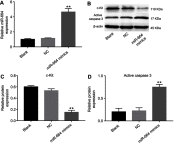MicroRNA-664 suppresses the growth of cervical cancer cells via targeting c-Kit
- PMID: 31409971
- PMCID: PMC6645611
- DOI: 10.2147/DDDT.S203399
MicroRNA-664 suppresses the growth of cervical cancer cells via targeting c-Kit
Abstract
Background: Cervical cancer is the second most common malignant cancer in women worldwide. Evidence indicated that miR-664 was significantly downregulated in cervical cancer. However, the mechanisms by which miR-664 regulates the tumorigenesis of cervical cancer remain unclear. Thus, this study aimed to investigate the role of miR-664 in cervical cancer.
Methods: Quantitative reverse transcription polymerase chain reaction was used to detect the level of miR-664 in tumor tissues and cell line. The dual luciferase reporter system assay and Western blotting were used to explore the interaction of miR-664 and c-Kit in cervical cancer.
Results: The expression of miR-664 in patients with cervical cancer was dramatically decreased compared with that in adjacent tissues. MiR-664 mimics significantly inhibited proliferation in SiHa cells via inducing apoptosis. In addition, miR-664 mimics induced apoptosis in SiHa cells via increasing the expressions of Bax and active caspase 3 and decreasing the level of Bcl-2. Moreover, dual-luciferase assay showed that c-Kit was the directly binding target of miR-664 in SiHa cells; overexpression of miR-664 downregulated the expression of c-Kit. Meanwhile, upregulation of miR-664 significantly decreased the levels of c-Myc and Cyclin D in cells. Furthermore, miR-664 markedly inhibited tumor growth of cervical cancer in xenograft.
Conclusion: Our data indicated that miR-664 exerted antitumor effects on SiHa cells by directly targeting c-Kit in vitro and in vivo. Therefore, miR-664 might be a potential therapeutic target for the treatment of patients with cervical cancer.
Keywords: apoptosis; c-Kit; cervical cancer; microRNA-664.
Conflict of interest statement
The authors report no conflicts of interest in this work.
Figures






Similar articles
-
MicroRNA-7-5p Promotes Cisplatin Resistance of Cervical Cancer Cells and Modulation of Cellular Energy Homeostasis by Regulating the Expression of the PARP-1 and BCL2 Genes.Med Sci Monit. 2018 Sep 16;24:6506-6516. doi: 10.12659/MSM.910969. Med Sci Monit. 2018. PMID: 30219819 Free PMC article.
-
miR-140-3p impedes the proliferation of human cervical cancer cells by targeting RRM2 to induce cell-cycle arrest and early apoptosis.Bioorg Med Chem. 2020 Feb 1;28(3):115283. doi: 10.1016/j.bmc.2019.115283. Epub 2019 Dec 19. Bioorg Med Chem. 2020. PMID: 31902649
-
miR-126 Suppresses the proliferation of cervical cancer cells and alters cell sensitivity to the chemotherapeutic drug bleomycin.Asian Pac J Cancer Prev. 2014 Jan;14(11):6569-72. doi: 10.7314/apjcp.2013.14.11.6569. Asian Pac J Cancer Prev. 2014. PMID: 24377569
-
The mechanisms involved in miR-9 regulated apoptosis in cervical cancer by targeting FOXO3.Biomed Pharmacother. 2018 Jun;102:626-632. doi: 10.1016/j.biopha.2018.03.019. Epub 2018 Apr 5. Biomed Pharmacother. 2018. PMID: 29602130
-
MiR-499b-5p inhibits cervical cancer cell proliferation and induces apoptosis by targeting the Notch1 signaling pathway.Eur Rev Med Pharmacol Sci. 2021 Oct;25(20):6220-6231. doi: 10.26355/eurrev_202110_26992. Eur Rev Med Pharmacol Sci. 2021. PMID: 34730202
Cited by
-
miR-23b-3p, miR-124-3p and miR-218-5p Synergistic or Additive Effects on Cellular Processes That Modulate Cervical Cancer Progression? A Molecular Balance That Needs Attention.Int J Mol Sci. 2022 Nov 4;23(21):13551. doi: 10.3390/ijms232113551. Int J Mol Sci. 2022. PMID: 36362337 Free PMC article. Review.
-
Small Nucleolar Derived RNAs as Regulators of Human Cancer.Biomedicines. 2022 Jul 28;10(8):1819. doi: 10.3390/biomedicines10081819. Biomedicines. 2022. PMID: 36009366 Free PMC article. Review.
-
Hsa_circ_0084927 Regulates Cervical Cancer Advancement via Regulation of the miR-634/TPD52 Axis.Cancer Manag Res. 2020 Oct 2;12:9435-9448. doi: 10.2147/CMAR.S272478. eCollection 2020. Cancer Manag Res. 2020. PMID: 33061631 Free PMC article.
-
Nobiletin in Cancer Therapy: How This Plant Derived-Natural Compound Targets Various Oncogene and Onco-Suppressor Pathways.Biomedicines. 2020 May 5;8(5):110. doi: 10.3390/biomedicines8050110. Biomedicines. 2020. PMID: 32380783 Free PMC article. Review.
-
The role of HPV-induced epigenetic changes in cervical carcinogenesis (Review).Biomed Rep. 2021 Jul;15(1):60. doi: 10.3892/br.2021.1436. Epub 2021 May 20. Biomed Rep. 2021. PMID: 34094536 Free PMC article. Review.
References
-
- Parkin DM, Bray F, Ferlay J, Pisani P. Estimating the world cancer burden: Globocan 2000. Int J Cancer. 2001;94(2):153–156. - PubMed
-
- de Freitas AC, Gomes Leitao Mda C, EC Coimbra. Prospects of molecularly-targeted therapies for cervical cancer treatment. Curr Drug Targets. 2015;16(1):77–91. - PubMed
-
- Shishodia G, Verma G, Das BC, Bharti AC. miRNA as viral transcription tuners in HPV-mediated cervical carcinogenesis. Front Biosci (Schol Ed). 2018;10:21–47. - PubMed
-
- Filippeschi M, Moncini I, Bianchi B, Florio P. What kind of surgery for cervical carcinoma? G Chir. 2012;33(4):139–146. - PubMed

